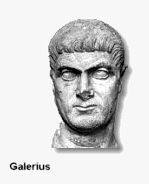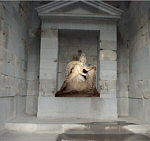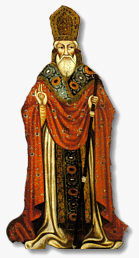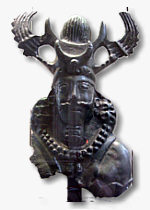The Conversion of the State
Gregory the Illuminator, T'rdat III and the Pagan Wars
Tour Armenia
TIME OF CONVERSION GREGORY THE ILLUMINATOR PAGAN WARS
The Time of Conversion
Armenian tradition dates the official recognition of the Christian faith and the construction of the first churches to the year 301 AD. As with so much of Armeniaís history, the story of Christianity mixes fact with myth and legend, and it is sometimes hard to know the difference between them. But also like so much of Armenian history, the identity of Armenians is found in both the myth and the fact.
At the time of conversion, Armenia was under the protection of Rome, but faced with a new invasion by the new Persian Sassanid dynasty. Beginning in the second half of the 3rd century, the Armenian plateau was repeatedly invaded by the Romans (Alexander Severus, Valerian, followed by Diocletian and Galerius) and by the Sassanid Persians (Ardashur I, Shapur I and Narses), leading, in 387, to an initial division of Armenia between the two empires.
The truce with the Persians in Nisibi, in 298, enabled Diocletian, Augustus of the Orient, to create five Roman provinces beyond the Tigris, and facilitated a period of relatively peaceful relations between the two empires. It also launched the systematic repression of the Christians, who were by now considered a source of social instability. These were carried out by Diocletian's most trusted general, Galerius, who was appointed governor of the eastern regions of the empire, including Armenia.
 The succession of Galerius, following the abdication of Diocletian in 305 AD, led to particularly severe repressive measures against Christians, inspired by the new emperor's fanatical attachment to the Roman pagan tradition. Tradition has it that after a serious illness during the winter of 310-311, Galerius - having repented his crimes - issued a decree at Nicomedia on 30 April 311 urging clemency for the Christians under his jurisdiction, two years before the more famous Edict of Milan issued by the Emperor Constantine. Some have thrown doubt on the year 301 AD for Armeniaís conversion, pointing to the improbability of Tírdatóa close vassal of the Roman generalóconverting his country to Christianity when it would be a direct challenge to Rome at the height of their persecutions. These doubts are given substance by historic accounts noting the official baptism of Tírdat and his court in 311 AD, when Gregory was anointed archbishop at Caesura. However, a deeper look at the political and economic situation in Armenia at the time provides an impetus for an earlier conversion. The succession of Galerius, following the abdication of Diocletian in 305 AD, led to particularly severe repressive measures against Christians, inspired by the new emperor's fanatical attachment to the Roman pagan tradition. Tradition has it that after a serious illness during the winter of 310-311, Galerius - having repented his crimes - issued a decree at Nicomedia on 30 April 311 urging clemency for the Christians under his jurisdiction, two years before the more famous Edict of Milan issued by the Emperor Constantine. Some have thrown doubt on the year 301 AD for Armeniaís conversion, pointing to the improbability of Tírdatóa close vassal of the Roman generalóconverting his country to Christianity when it would be a direct challenge to Rome at the height of their persecutions. These doubts are given substance by historic accounts noting the official baptism of Tírdat and his court in 311 AD, when Gregory was anointed archbishop at Caesura. However, a deeper look at the political and economic situation in Armenia at the time provides an impetus for an earlier conversion.
The Sassanid's brokered a peace with the Romans and divided the Armenian Kingdom between the two powers after having eliminated the Arshakid ruling class in Persia. The Armenian King Tírdat was a Parthian-Arshakid, and was related to the Persian Arshakid royal house by generations of intermarriage between the two kingdoms. The destruction of the Arshakid ruling class was a blow not only to the peace between Armenia and Persia; it was the end of blood ties between the ruling houses of each country. As a result of the Sassanid invasion, the Armenian kingdom was in a state of crisis. Tírdat was well aware that with the rise of the Sassanid's in Persia, his own rule was in jeopardy, and eventual invasion of his remaining kingdom only a matter of time.
For several centuries Armenians had shared language, culture and religion with the Arshakid Persians. Threatened with invasion by the Sassanid ďbarbariansĒ, Tírdat needed to separate the Armenians from their ties to Persiaís culture, or face total assimilation in the new empire. Not to mention annihilation of his own royal house. The immediate threat by Persia was greater than possible repercussions by Romans persecuting Christians West of his kingdom and Tírdat had other influences to turn to the Christian faith.
 Tírdatís grandfather had secretly converted to Christianity. Even during the worst of Roman persecutions, there is no record of a systematic persecution against Christians in Armenia at the time of conversion. In fact, Armenia was considered a safe haven for Christians escaping persecutions. No doubt this created tensions between the Empire and Armenia, precipitating the events of 301-311 AD. Tírdatís grandfather had secretly converted to Christianity. Even during the worst of Roman persecutions, there is no record of a systematic persecution against Christians in Armenia at the time of conversion. In fact, Armenia was considered a safe haven for Christians escaping persecutions. No doubt this created tensions between the Empire and Armenia, precipitating the events of 301-311 AD.
At the end of the 3rd century a group of Christian converts, led by Hripsimeh (called the thirty-nine virgins), who were from the noble Roman class, came to Armenia to escape persecution in the Western Empire. They found refuge, and began preaching the new faith in and around Vagharshapat (present-day Echmiadzin).
Legend has it that when Tírdat heard of the noble virgin Hripsimeh (already a legend for her beauty), he commanded her to come to his presence. Struck by her extraordinary beauty, he asked her to live with him in his palace. She refused, saying she was engaged to Christ and could marry no mortal. Spurned by her refusal, T'rdat imprisoned her and her followers.
Eventually they escaped, and Tírdat ordered they be captured and Ďmade an example ofí. The soldiers caught the fleeing group and stoned them to death. Their martyrdom, combined with the story of Gregory the Illuminator to give birth to the fervently held story of how Armenia came to adopt Christianity.
 Gregory the Illuminator Gregory the Illuminator
The story of Grigor (Gregory) Parthev, of Parthian origin like King Tírdat III but raised in Caesura, where he encountered the Christian faith, is connected to the destiny of the king. Grigorís father Anak, was responsible for the death of Tírdatís father. And Grigor was the one born on the spot where the apostle Thaddeus had been killed. Traditional accounts say that Grigor devoted himself to the monastic life to atone for his father's crime. One of the nobles who joined T'rdat on his march to Armenia, Grigor knew his father was responsible for the death of Khosrov the Great, but he also knew that Khosrov had ordered the extinction of his family. One can only imagine what went through his mind on the long march from Caesurae to Armenia, and in the events that followed. For the record shows that T'rdat did not know of Grigor's identity until he had ascended the throne.
Tírdat III, a fervent pagan under Roman protection, tried to re-establish the old religion in his kingdom, offering sacrifice to Anahit once he ascended to the throne. He ordered Grigor to imitate the other officers in placing a wreath of flowers before her image, but Grigor refused, declaring himself a Christian, and was subjected to terrible tortures. Learning that Grigor was the son of the man who murdered his father, T'rdat had him thrown into chains and sent to Artashat, where he was imprisoned for twelve years in a dry well known as "Virab".
After a grave illness (represented in Armenian stone carvings by placing the head of a jackal on Tírdatís body) the king was told by his sister (herself converted to the new faith) that only Grigor could cure him. When commanded to attend the king, Grigor told Tírdat that he would be relieved of his madness only if he were to publicly repent of his sins and erect martyria in honor of three of the 39 Virgins (Hripsimeh, Gayaneh and Shoghokat) he had ordered killed. Tírdat agreed, and Grigor cured him.
To show his gratitude, Tírdat agreed to be converted to the Christian faith, together with his family. Grigor, who returned in 310 to Caesura to take his vows and, at the same time, to be ordained bishop by the Greek archbishop Leontius, baptized the royal family and its entourage on the banks of the River Euphrates in 311 AD.
This date coincides with Galeriusí edict of clemency for Christians in the winter of 310-311, suggesting the official conversion of the state more likely to have occurred in 311. Others point to a separate set of events that make the earlier date the time of conversion (see how messy History is?)
These historians point to Tírdatís decision to convert together with his entire family as a tactical move to preserve his kingdom. By allowing Grigor to become the first Catolicos (supreme patriarch of the Armenian church), it maintained the hold of power within the Parthian class. During the entire 4th century the succession of the Catolicos was ensured by the direct line of male descendants of Grigor, legitimizing the role of spiritual father of the Armenian Church in the same degree that the male descendants of the Arshakid dynasty were legitimized as successors to the throne of Armenia. It also facilitated solidarity among the feudal nobles of the nation.
And it preserved a distinctly Armenian identity in the face of impending invasions by Sassanid Persians. Whether in 301 or in 311, the kingdom of Armenia became the first to officially embrace Christianity as its state religion. The Roman Empire did not do so until 380, under the Emperor Theodosius.
 The Pagan Wars The Pagan Wars
Later, however, a lack of unity between the new Christian ruling class (king, Catolicos and clergy) and the population grew. Some districts readily converted to the new religion, while there were others in which the pagan element was more deeply rooted and involved economic and social interests. Pagan priests, who, thanks to their position had been able to accumulate massive fortunes, controlled large numbers of peasants who cultivated their lands, whom if armed could react to threats to their hegemony. The conversion of the country, imposed from above, did not always take place in a peaceful manner.
In fact what followed was a Holy War between the forces of the new faith and the pagan districts. The historian Agathangelos describes in his history of the era how Gregory destroyed all signs of Pagan religion before erecting crosses and new churches on the ruins of sun worship temples. Evidence shows that all traces of the written Armenian language were also destroyed in the same campaign.
T'rdat reigned for 56 years, and after his death, the country was thrown into anarchy. Pagan leaders, who had only accepted Christian leadership out of fear, revolted, and formed an alliance with the Sassanids. The ruling house sent a petition to the Emperor Constans asking that T'rdat's son Khosrov be appointed king. The emperor answered by arriving with a great army and placing Khosrov II (342-350) on the throne.
A new capital was built at Dvin, near the river Azat, a tributary of the Arax, and the greater part of the population of Artashat was transferred there. King Khosrov II ordered the planting of a large forest nearby, which he stocked with numerous animals, and which still exists as the Khosrov Nature Preserve.
Khosrov was barely cold in his grave, and the 40-year truce of Nisibi had barely ended when the Persian King Shapur II invaded Mesopotamia and Armenia. With only brief interruptions the war continued for fifty years.
The struggle over religious supremacy continued for 300 years, but was basically decided during the reign of Catolicos Nerses I the Great (353-358), the sixth supreme patriarch of the Armenian Church in direct descent from St. Gregory the Illuminator. Nerses extended the churchís mission to the furthest regions of the kingdom, in which the worship of pagan idols was still very widespread.


 Top
Top

|
